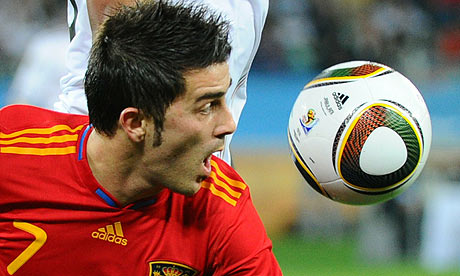The Question: Is 4-2-1-3 the future?
Although little different from 4-2-3-1, it is significant if the central creator plays deeper, for a whole number of reasons

Evolution never stops. As the World Cup showed, 4‑2‑3‑1 has come to replace 4‑4‑2 as the universal default (18 of the 32 teams played some form of 4‑2‑3‑1 at some stage, with another three fielding a 4‑4‑2 that perhaps should have become 4‑2‑3‑1) so the system at the very highest level has already begun to mutate. Spain, by the end of the World Cup, had followed what Barcelona did at times last season, what Arsenal seemed to be reaching towards, and set up in a 4‑2‑1‑3.
Now clearly the distinction between 4‑2‑3‑1 and 4‑2‑1‑3 is minimal. It entails nothing more than the central player in the trident pulling a little deeper and the two wide players advancing slightly. In practice, as the wide players look to escape the attentions of full-backs, their depth of position may not alter greatly, but to refer to the system as 4‑2‑1‑2‑1 and start introducing a fifth band is probably to begin to confuse the simplicity that gives value to the practice of assigning numerical codes. The shape, if anything, resembles a diamond sitting on a plinth. As I've said before, the designations are of course crude, but they have a use in providing a broad explicatory template.
The key differences in the formations
Yet it is significant if that central creator plays deeper, for a whole number of reasons. To begin with, if the playmaker operates close to the holding pair, the team cannot be "broken" into attacking and defensive sections as Holland and Argentina were at the World Cup (which is an advantage for those sides that believe in a possession-based approach). By definition, by being only a short pass away from the creator, the two midfield holders are more involved in the attacking aspect and at least one of them can be encouraged to press forwards at times, as Xabi Alonso did for Spain, and as Seydou Keita does for Barcelona. So immediately the range of attacking options is increased.
There is also an impact on the creator himself. Playing a touch deeper offers him three advantages. He is nearer the two holding players, who can be considered his protectors, which makes it harder physically to intimidate him, while his more withdrawn position means he is farther from the opposing holding midfielders, harder to pick up and thus likely to have more time on the ball (not that Xavi or Cesc Fábregas really needs more time on the ball; one of the joys of watching Spain or Barcelona recently, or Holland or West Germany of the 70s, is their willingness to give the ball to a man under pressure, trusting his technique to release it and change the angle of attack).
The creator is also more likely to receive the ball facing goal – or at least to have time to turn so he is facing goal – with three team-mates ahead of him (as opposed to one ahead and two alongside) and the potential of others breaking from deep, and so he becomes something more like an old-fashioned playmaker than a second striker who tends to receive the ball with his back to goal. That, in theory, should make the transfer of ball from back to front quicker and thus make a side more penetrative (the example of Chile's 3‑3‑1‑3 at the World Cup suggested that leaving players perpetually high up the pitch helps in terms of pressing and regaining the ball quickly, but can lead to the retention of possession at the expense of penetration). As Juan Román Riquelme points out, a playmaker is only effective if he has players available for whom to make the play.
Which teams have adopted this tactic?
Just as significant, though, is the effect withdrawing the central creator has on the two wide forwards. Rather than having to stay wide to offer a passing option and so as not to intrude on the central player's space, they can drift infield, as Pedro and Andrés Iniesta did regularly for Spain, and as both and Lionel Messi do for Barcelona. That draws them away from the full-back into more awkward areas, and opens space on the overlap for attacking full-backs, who are liberated by the presence of four essentially defensive central players (two centre-backs and two holding midfielders), plus the creator, who can tuck in if necessary.
If Iniesta is included on the left, Messi on the right and Xavi in the middle, Barcelona effectively have a trident of playmakers, all able to interchange and all operating in positions that drag opponents out of their comfortable lines. Or, a more natural forward can be played in one of the wide positions – David Villa, perhaps, with Zlatan Ibrahimovic as the centre-forward – which offers effectively two playmakers (one of whom, Messi, is devastating as a forward anyway), with a central striker adept with his back to goal, and a forward, one of the best finishers in the world, cutting in from the left, able to take advantage of the space available on the diagonal. And all that with Dani Alves and Maxwell overlapping from full-back.
Although Arsenal seem likely to attempt something similar this season, with Fábregas in the Xavi role, backed up by Abou Diaby and Alex Song, Andrei Arshavin and Robin van Persie wide, and Marouane Chamakh offering some muscle at centre-forward, it may prove a formation of limited application, purely because the demands on the playmaker are so great: he must combine the ability to see and execute with at least some of the physicality of a central midfielder, even with two protectors. But when a team has a player like that, 4‑2‑1‑3 may be the way to get the best out of him.


No comments:
Post a Comment